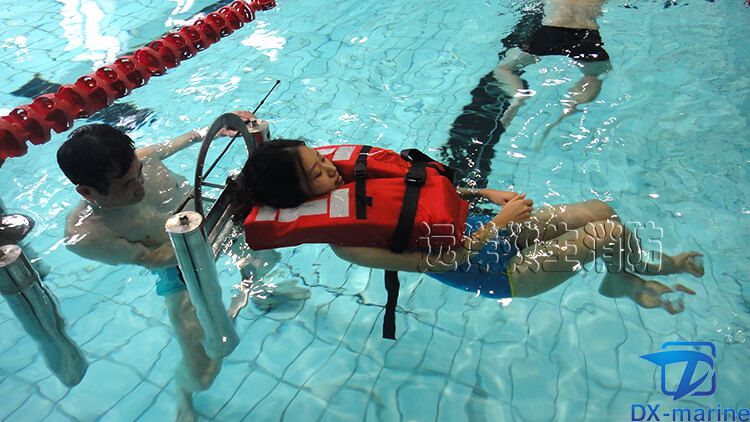Precautions for marine life jacket
Lifejackets are designed to provide full support for a person in the water, even if that person is unable to help themselves and is heavily clothed. Without a lifejacket even good swimmers will have difficulty staying afloat in cold water because of the disabling effects of cold shock and cramp.
Lifejackets may be constructed from foam or other permanently buoyant material, or they may be inflatable or partially inflatable. Any lifejacket provided must be one that is suitable for the task in hand. It should be in good condition and correctly secured Ideally it will be provided with a crotch strap in order to maintain it in the correct position.
General Requirements for SOLAS Lifejackets.
A lifejacket must:
-
Support in the water a fully clothed person.
-
In less than five seconds turn an unconscious person in the water from any position to one where the mouth is at least 120 mm clear of the water with the body inclined backwards at an angle of not less than 20° from the vertical. A child lifejacket is only required to lift the mouth clear of the water by an appropriate distance.
-
Not have its buoyancy reduced by more than 5% after twenty-four hours submerged in fresh water.
Be so designed that someone unfamiliar with the lifejacket candon it unaided within one minute (small children may be assisted when donning the lifejacket). It must be clearly capable of being donned only the correct way, and, as far as practicable, may not be donned incorrectly. It must be comfortable to wear.
Allow the wearer to jump from at least 4.5m into water without injury, and without dislodging or damaging the lifejacket.
Not continue burning or melting after being totally enveloped in a fire for a period of two seconds.
In the case of a child lifejacket, be marked with the height or weight range for which the lifejacket is applicable.
Be fitted with a whistle.
Be of a highly visible colour (in the case of inflatable lifejackets the colour requirement refers to the inflated lifejacket only).
Inflatable Lifejackets
In addition to the above listed general requirements a SOLAS lifejacket which depends on inflation buoyancy must:
-
Not have less than two separate compartments.
-
Inflate automatically on immersion, be provided with a device to manually initiate inflation, and be capable of being inflated by mouth.
Lifejackets for Totally Enclosed & Free Fall Lifeboats Lifejackets used in totally enclosed and free fall lifeboats must not impede entry to the lifeboat, seating arrangements, use of the seat belts and operation of the lifeboat or occupant safety. In a free-fall lifeboat only inflatable lifejackets are permitted.
For SOLAS vessels
•One for each person on board.
•Plus lifejackets for persons on watch (e.g. bridge, engine control room, and other manned watch stations) stowed at the watch stations.
•Plus lifejackets for use at remotely located survival craft positions.
Additional requirements for passenger ships
•Plus child lifejackets for at least 10% of the total number of passengers on board or one lifejacket for each child, whichever is the greater number.
•Plus an additional 5% of the total number of persons on board. These lifejackets are to be conspicuously stowed in places on deck or at the muster stations.

STOWAGE
Lifejackets are to be readily accessible and their positions clearly indicated. If there is the possibility of the lifejackets becoming inaccessible alternative arrangements must be made, which may include increasing the number of lifejackets carried.
Lifejackets must be stored in an accessible, clearly marked, dry place. They are to be always in a ready-to-use condition.
CARE AND INSPECTION OF LIFEJACKETS
Lifejackets should be treated with care in order that, when required, they can save your life! Regularly check that any tie tapes, straps and buckles are in good order and securely attached: make sure that any stitching is sound and that any welded or glued seams are closed; the retro- reflective tape, whistle and light must be securely attached; and the light battery in date.
If the lifejacket requires cleaning use only luke-warm fresh water and mild soap. Lifejackets with an automatic inflation mechanism can only be rinsed in water if the mechanism has been de-activated. Do not use detergents, bleach or cleaning fluids to clean the lifejacket and do not place it in a washing machine or tumble dryer. Allow the lifejacket to dry naturally.
Inflatable lifejackets are normally serviced once a year, but should be inspected at more frequent intervals. To service an inflatable lifejacket (normally undertaken by the manufacturers’ agent).
• Remove the gas cylinders. Check that the seals are not pierced and check for signs of corrosion. Weigh the cylinder and compare the weight with the gross weight marked on the cylinder.
• For automatic inflation lifejackets check that the automatic capsules are still operative and are not clogged with dirt.
• Examine the firing heads and test their operation by pulling the manual inflation cord to see that the firing pin travels freely and that both pin and lever return freely.
• Inspection of the automatic inflation mechanism will vary according to the manufacturer. Consult the instructions appropriate to the type of lifejacket in use.
• Check the air holding properties of the lifejacket by orally inflating it and leaving it overnight (in a consistent temperature). If air loss does occur then deliver the lifejacket to the manufacturers' agent for repair.
